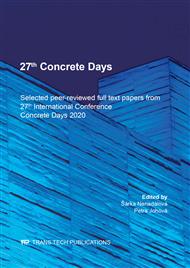p.48
p.54
p.60
p.66
p.72
p.78
p.87
p.94
p.100
Properties of Spanish Broom Fiber Reinforced Concrete
Abstract:
Building materials based on renewable resources such as plant fibers are increasingly needed, especially if the plant is local and easily accessible. One such plant is the Spanish broom, a typical shrub of the Mediterranean region. In this work, Spanish broom fibers were used for the first time to reinforce concrete. Four mixtures were made: a reference mixture and three mixtures reinforced with 3 cm long fibers, in the amount of 0.5% of the total volume. Cement CEM I 42.5R, crushed limestone aggregate (D = 16 mm), and tap water were used for all the mixtures and in equal quantities. Four mortar mixtures were also made: standard mortar and 3 fiber-reinforced mortars. The mortar is reinforced with fibers of the same length and quantity as the concrete. The fibers were obtained by maceration of Spanish broom in solutions of 8%, 10%, and 15% NaOH. The quality and mechanical properties of the cellulose fibers depend on the geographical and climatic conditions and the fiber extraction procedures so the aim of this study was to evaluate the influence of different chemical pre-treatments of the fibers on the mechanical properties of the concrete. The properties of the fresh mix were determined using the flow method. Hardened concrete was tested for compressive and flexural strength and dynamic modulus of elasticity. Compressive and flexural strengths were determined on cement mortars. The results obtained on concrete were compared with those obtained on the mortar. It was concluded that the quality of composite materials is more influenced by the quality of the placement than by fiber treatment.
Info:
Periodical:
Pages:
72-77
Citation:
Online since:
August 2021
Price:
Сopyright:
© 2021 Trans Tech Publications Ltd. All Rights Reserved
Share:
Citation:


